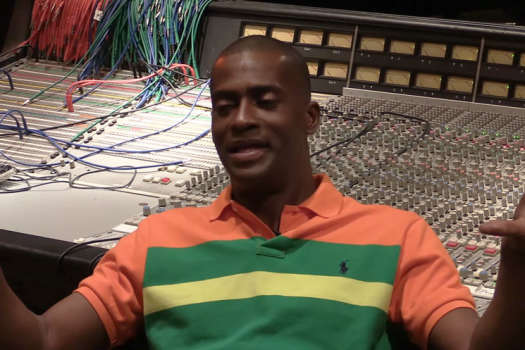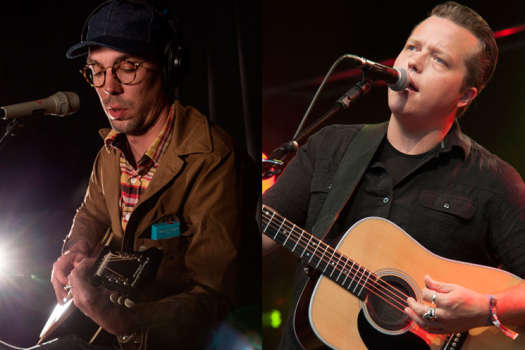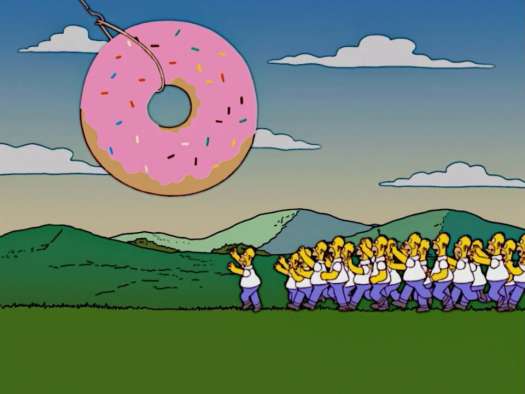The record company you've founded is about to celebrate its tenth anniversary. There will be a triple CD retrospective to chronicle the incredible influence your label has had on international beat culture. There are going to be several nights of parties in London, followed by a world tour in the fall. Several months of your time are to be spent promoting your company's success. So how did Matt Black, one half of sample pioneers Coldcut, the progenitors of Ninja Tune records, spend his summer vacation? Bombing around Europe in a VW van staging audio-visual freak-outs at the drop of a hat. "I've had a very good time in the last few weeks, in a truck with loads of people, doing parties in Spain and France. We've done a VJ conference, we did a party on the beach in Barcelona. We're trying to get a de facto circus vibe going, to try to experiment with it." Spontaneous, creative multimedia entertainment with a solid thump is what defines Matt Black, Coldcut and by extension, Ninja Tune Records. Ninja Tune represents more than just a cool bunch of records, it is an extension of Coldcut's musical, visual and business philosophies.
The Coldcut aesthetic began in the late 80s, inspired by the intricate sampled work of Steinski and Mass Media, pioneers of rapidly cut-up "beats n' pieces." Two recordings brought them great attention, "Say Kids, What Time is It?" and their brilliant remix of Eric B. and Rakim's "Paid In Full." Their sample constructions were not unlike what the Bomb Squad and especially Prince Paul were doing in the U.S., but Coldcut's style was British, not American ? beyond the vocal edits, Coldcut's grooves hybridised funk, reggae, hip-hop, jazz, and electro in ways no one was doing Stateside at the time. These were the records they were playing on their Solid Steel radio show (still going, check www.ninjatune.net) on hugely influential pirate radio station KISS-FM, alongside like-minded folk like Talkin' Loud Records' Gilles Peterson and Patrick Forge (Rebirth of the Cool series and Da Lata).
Coldcut released two CDs on Big Life records before it was absorbed by Arista, but they found themselves increasingly at odds with the major label's strict format requirements, release schedules and overall expectations. Coldcut wanted be in position to release what they wanted, when they wanted.
Mulling their situation over while touring Japan, Black and Coldcut partner Jonathan More seized on the concept of the Ninja, a warrior who operates by stealth. Ninja Tune was born in 1990. Coldcut began to release music under different identities ? their DJ Food alias stepped up with the first in the Jazz Brakes series. Many acknowledge those records to be the birth of trip-hop, but they were more akin to tools for DJs, and not "songs" per se. This was an early example of the possibilities of releasing "tools" for people to use as they wish ? an idea that continues to evolve ten years later. Early on, Ninja Tune established a reputation as a label producing funky possibilities with digital technology combined with live instrumentation, a more ambitious, yet soulful mix of ideas than either trip-hop or acid jazz had to offer. Almost as important as the music was the graphic excellence of the Open Mind design team, which ensured Ninja releases stood out on the racks.
Ninja releases have continually set new standards in electronic creativity, spurring artists around the world to follow their lead. Refried Food (1996) by DJ Food defined the concept of the remix album, with contributions from Luke Vibert, Fila Brazilia, Squarepusher, Autechre and Ashley Beedle. The Herbaliser kicked the live/programmed hip-hop equation up a notch with the superb Blow Your Headphones (1997), an inspiring reconstruction of live jams, turntables and electronic manipulation. Jaws dropped everywhere at Amon Tobin's second album, Permutation (1998) ? his breaks sounded like reconstituted Max Roach, brimming with complexity and organised into songs both super-sophisticated and party rockin'. More than just meticulously chopped up samples, Tobin's ability to express his Anglo-Brazilian rhythmic heritage with breakbeats was truly remarkable. And Kid Koala's Carpal Tunnel Syndrome could be this year's best album. The Kid upped the turntable ante, going beyond beats into a wacky, musique concrete-ish scratchappyland. The love of blended, globally-aware influences that inspired Coldcut in the first place is being brilliantly posited by each new Ninja artist.
Ninja's artistic success was made possible by two solid business moves, the first of which was the establishment of a Montreal office. While many UK indies set up shop in expensive Manhattan digs, the Montreal operation has kept overhead low. Jeff Waye, who heads Ninja Montreal with Philippa Klein, says, "When you're selling most of your records to the U.S. and your expenses are in Canadian dollars, it's a pretty nice set-up. We were worried at first that if the Americans looked at the address they'd think it wasn't domestic, but as long as the price reflects that it's domestic, nobody really cares." Ninja has experienced steady growth in the last five years as a result of low overhead and favourable distribution, avoiding the temptation to overextend themselves, as many suddenly popular labels do.
The other important business move for Ninja was not licensing its artists or albums individually. The entire catalogue is distributed as a whole. Artists don't get lost in the shuffle as they would at a major. Says Waye: "With a normal licensing deal, they just want the top end of the catalogue. Probably in 1997, through that type of deal, a licensor probably wouldn't have picked up Amon Tobin. They would have thought he was too uncommercial ? they tend not to be adventurous and they want proven successes. But because we're set up the way we are, he's one of the biggest things on our label."
Steady growth based on solid business principles has allowed Ninja to branch out, launching sub-labels over the years to put out sounds that go beyond the funk/dub/jazz/ roots that characterise the main label. Ntone was launched in 1994 to explore techno and ambient-influenced music. The Ntone line-up includes Neotropic, Animals on Wheels, Cabbage Boy, and Flanger ? all of whom have put out worthy releases in the last year-and-a-half. Big Dada, their rap imprint, has been another important success. In keeping with the overall Ninja mandate, Big Dada artists blend a variety of musical and cultural influences ? d&b, Bollywood music, and lots of West Indian vibes combine with incisive (or just plain bizarre) lyrics to produce highly creative rap. Big Dada has released crucial records by Roots Manuva, New Flesh For Old, and most recently, the Infesticons. Matt Black is especially proud of Big Dada: "It's giving back to the community; it's not making a whole lot of money but it's doing pretty okay. We never did it to make money. I would encourage people to know the roots of the music and give thanks to all the people whose musical culture has been built on, who may have lived a pretty horrible life." Furthering Ninja's commitment to rap, they recently began distributing Quannum (formerly known as Solesides) out of San Francisco.
Ninja's cyber-activities have become as renowned as their CD releases. Coldcut, as has been their passion for the last ten years, have been leading the Ninja charge into new forms of digital deconstruction, extending the original concept of the Jazz Brakes series. Black designed Ninja's first web site way back in 1995, and it has expanded to the point that one can spend days (no exaggeration) navigating Ninja's main site and the artist micro-sites. Coldcut have also been developing new ways to write and perform audio and visual material. Coldcut's 1997 album Let Us Play was chock full of videos, games and interactivity before the "enhanced CD" was commonplace. And the duo are expanding into the realm of software, having written a program called VJamm, which allows for the real time manipulation of audio and visual samples. As Black explains: "You can do films, or new types of multimedia right on the desktop with your posse. It's a very powerful idea ? it's the realisation of a lot of the hippie ideals of the 60s with a lot of the punk DIY feeling, and now technology's allowed that to flower. I'm more interested in releasing software than releasing albums, releasing music. I'm interested in the idea of meta-art ? art to create more art. It's more next school to be releasing software to enable people to make music." PirateTV, a home for VJamm-ing is their latest and most ambitious venture. It first webcast in January 1999, featuring Coldcut and their ambient/ dub/ disco/ political/ whatever associates. The international acclaim heaped on PirateTV is what spurred Black to get back in the van once again and do it live. Coldcut will be VJamm-ing their way through North America with all their latest tricks starting this month.
For now, though, the Xen Cuts triple CD set represents the great collective statement of Coldcut, their fellow artists, and those behind the scenes at Ninja Tune. Black muses on how beat-oriented global musical culture has progressed in the last ten years. "Sometimes it's a bit shocking, sometimes it comes home to me how much music all over the world is derived from a few music genes. A surprising number have come from sort of ghetto' environments, predominantly black and other ethnic minorities. Out of that energy you get incredible flavours coming out. Hip-hop from the Bronx, house from Chicago, gogo from Washington, techno from Detroit and reggae from Jamaica. They've been so potent, those strains, in colonising the world's music consciousness." Surely Ninja Tune has provided some of the most interesting and non-exploitative hybrids of these musical strains. Ninja Tune's artists hail from all parts of the world, each has developed music that reflects their local and national origins, their global perspectives and the funk. Its evolution of sample-based art continues to demonstrate that both audio and visual realms can feature the most subtle and individual of statements.
The Coldcut aesthetic began in the late 80s, inspired by the intricate sampled work of Steinski and Mass Media, pioneers of rapidly cut-up "beats n' pieces." Two recordings brought them great attention, "Say Kids, What Time is It?" and their brilliant remix of Eric B. and Rakim's "Paid In Full." Their sample constructions were not unlike what the Bomb Squad and especially Prince Paul were doing in the U.S., but Coldcut's style was British, not American ? beyond the vocal edits, Coldcut's grooves hybridised funk, reggae, hip-hop, jazz, and electro in ways no one was doing Stateside at the time. These were the records they were playing on their Solid Steel radio show (still going, check www.ninjatune.net) on hugely influential pirate radio station KISS-FM, alongside like-minded folk like Talkin' Loud Records' Gilles Peterson and Patrick Forge (Rebirth of the Cool series and Da Lata).
Coldcut released two CDs on Big Life records before it was absorbed by Arista, but they found themselves increasingly at odds with the major label's strict format requirements, release schedules and overall expectations. Coldcut wanted be in position to release what they wanted, when they wanted.
Mulling their situation over while touring Japan, Black and Coldcut partner Jonathan More seized on the concept of the Ninja, a warrior who operates by stealth. Ninja Tune was born in 1990. Coldcut began to release music under different identities ? their DJ Food alias stepped up with the first in the Jazz Brakes series. Many acknowledge those records to be the birth of trip-hop, but they were more akin to tools for DJs, and not "songs" per se. This was an early example of the possibilities of releasing "tools" for people to use as they wish ? an idea that continues to evolve ten years later. Early on, Ninja Tune established a reputation as a label producing funky possibilities with digital technology combined with live instrumentation, a more ambitious, yet soulful mix of ideas than either trip-hop or acid jazz had to offer. Almost as important as the music was the graphic excellence of the Open Mind design team, which ensured Ninja releases stood out on the racks.
Ninja releases have continually set new standards in electronic creativity, spurring artists around the world to follow their lead. Refried Food (1996) by DJ Food defined the concept of the remix album, with contributions from Luke Vibert, Fila Brazilia, Squarepusher, Autechre and Ashley Beedle. The Herbaliser kicked the live/programmed hip-hop equation up a notch with the superb Blow Your Headphones (1997), an inspiring reconstruction of live jams, turntables and electronic manipulation. Jaws dropped everywhere at Amon Tobin's second album, Permutation (1998) ? his breaks sounded like reconstituted Max Roach, brimming with complexity and organised into songs both super-sophisticated and party rockin'. More than just meticulously chopped up samples, Tobin's ability to express his Anglo-Brazilian rhythmic heritage with breakbeats was truly remarkable. And Kid Koala's Carpal Tunnel Syndrome could be this year's best album. The Kid upped the turntable ante, going beyond beats into a wacky, musique concrete-ish scratchappyland. The love of blended, globally-aware influences that inspired Coldcut in the first place is being brilliantly posited by each new Ninja artist.
Ninja's artistic success was made possible by two solid business moves, the first of which was the establishment of a Montreal office. While many UK indies set up shop in expensive Manhattan digs, the Montreal operation has kept overhead low. Jeff Waye, who heads Ninja Montreal with Philippa Klein, says, "When you're selling most of your records to the U.S. and your expenses are in Canadian dollars, it's a pretty nice set-up. We were worried at first that if the Americans looked at the address they'd think it wasn't domestic, but as long as the price reflects that it's domestic, nobody really cares." Ninja has experienced steady growth in the last five years as a result of low overhead and favourable distribution, avoiding the temptation to overextend themselves, as many suddenly popular labels do.
The other important business move for Ninja was not licensing its artists or albums individually. The entire catalogue is distributed as a whole. Artists don't get lost in the shuffle as they would at a major. Says Waye: "With a normal licensing deal, they just want the top end of the catalogue. Probably in 1997, through that type of deal, a licensor probably wouldn't have picked up Amon Tobin. They would have thought he was too uncommercial ? they tend not to be adventurous and they want proven successes. But because we're set up the way we are, he's one of the biggest things on our label."
Steady growth based on solid business principles has allowed Ninja to branch out, launching sub-labels over the years to put out sounds that go beyond the funk/dub/jazz/ roots that characterise the main label. Ntone was launched in 1994 to explore techno and ambient-influenced music. The Ntone line-up includes Neotropic, Animals on Wheels, Cabbage Boy, and Flanger ? all of whom have put out worthy releases in the last year-and-a-half. Big Dada, their rap imprint, has been another important success. In keeping with the overall Ninja mandate, Big Dada artists blend a variety of musical and cultural influences ? d&b, Bollywood music, and lots of West Indian vibes combine with incisive (or just plain bizarre) lyrics to produce highly creative rap. Big Dada has released crucial records by Roots Manuva, New Flesh For Old, and most recently, the Infesticons. Matt Black is especially proud of Big Dada: "It's giving back to the community; it's not making a whole lot of money but it's doing pretty okay. We never did it to make money. I would encourage people to know the roots of the music and give thanks to all the people whose musical culture has been built on, who may have lived a pretty horrible life." Furthering Ninja's commitment to rap, they recently began distributing Quannum (formerly known as Solesides) out of San Francisco.
Ninja's cyber-activities have become as renowned as their CD releases. Coldcut, as has been their passion for the last ten years, have been leading the Ninja charge into new forms of digital deconstruction, extending the original concept of the Jazz Brakes series. Black designed Ninja's first web site way back in 1995, and it has expanded to the point that one can spend days (no exaggeration) navigating Ninja's main site and the artist micro-sites. Coldcut have also been developing new ways to write and perform audio and visual material. Coldcut's 1997 album Let Us Play was chock full of videos, games and interactivity before the "enhanced CD" was commonplace. And the duo are expanding into the realm of software, having written a program called VJamm, which allows for the real time manipulation of audio and visual samples. As Black explains: "You can do films, or new types of multimedia right on the desktop with your posse. It's a very powerful idea ? it's the realisation of a lot of the hippie ideals of the 60s with a lot of the punk DIY feeling, and now technology's allowed that to flower. I'm more interested in releasing software than releasing albums, releasing music. I'm interested in the idea of meta-art ? art to create more art. It's more next school to be releasing software to enable people to make music." PirateTV, a home for VJamm-ing is their latest and most ambitious venture. It first webcast in January 1999, featuring Coldcut and their ambient/ dub/ disco/ political/ whatever associates. The international acclaim heaped on PirateTV is what spurred Black to get back in the van once again and do it live. Coldcut will be VJamm-ing their way through North America with all their latest tricks starting this month.
For now, though, the Xen Cuts triple CD set represents the great collective statement of Coldcut, their fellow artists, and those behind the scenes at Ninja Tune. Black muses on how beat-oriented global musical culture has progressed in the last ten years. "Sometimes it's a bit shocking, sometimes it comes home to me how much music all over the world is derived from a few music genes. A surprising number have come from sort of ghetto' environments, predominantly black and other ethnic minorities. Out of that energy you get incredible flavours coming out. Hip-hop from the Bronx, house from Chicago, gogo from Washington, techno from Detroit and reggae from Jamaica. They've been so potent, those strains, in colonising the world's music consciousness." Surely Ninja Tune has provided some of the most interesting and non-exploitative hybrids of these musical strains. Ninja Tune's artists hail from all parts of the world, each has developed music that reflects their local and national origins, their global perspectives and the funk. Its evolution of sample-based art continues to demonstrate that both audio and visual realms can feature the most subtle and individual of statements.




